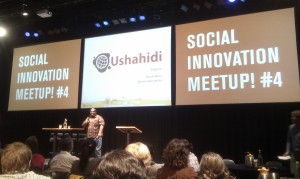 On April 25, Social Innovation Meetup #4, organized by Hivos and Kennisland, was held in Amsterdam. Theme: “Exploring Labs for Social Change”. Social innovation labs are very popular as instruments for “changing the system”. However, what actually happens in these labs? How do they help accomplish social change? What’s in “the black box”?
On April 25, Social Innovation Meetup #4, organized by Hivos and Kennisland, was held in Amsterdam. Theme: “Exploring Labs for Social Change”. Social innovation labs are very popular as instruments for “changing the system”. However, what actually happens in these labs? How do they help accomplish social change? What’s in “the black box”?
Keynote speakers sharing innovation stories from Kenya, Finland, and Canada were Daudi Were of
Ushahidi, Marco Steinberg of the
Helsinki Design Lab and Vanessa Timmer of
One Earth. In the two days prior to the meetup, representatives of living labs (hubs, experimental learning spaces, etc.) from all over the world gathered in “
Lab2“. Together, these people in the vanguard explored new examples and solutions for system change, some of which were reported at the meetup. There was also supposed to be a panel discussion to see how their lessons learnt might apply to the Dutch context, but unfortunately that part was cancelled.
The presentations were brief and intense, relaying a flurry of interesting ideas and references. Like at the
“Designing Social Cities of Tomorrow” workshop last year, I took presentation notes. They are rough, and only minimally edited, although I have added some links and excerpts from the sites linked to. Together, I think these notes give a nice overview of the many dimensions experienced at the international front lines of real social innovation.
Introduction
A brief introductory speech was given by Remco Berkhout of Hivos. There are many tough global problems, like climate change, for which there are no clearcut solutions. Hivos believes that citizen action is key to addressing these problems. People from all over the world are involved in such processes of social innovation. There are many interpretations of what is social innnovation: any idea that makes the world better, creativity of communities to make things better, popukar participation, with resources going to the communities, and so on. The silos need to go. Cities in the south can be great sources of inspiration. Given the pressing problems, labs there are often much more advanced than here in the West!
Daude Were (Ushahidi, Kenya)
In 2007, all hell broke loose after the Kenyan elections, resulting in many riots and murders. Many stories were un(der)reported. We needed to find stories of what was happening, curate them, map them, and archive them. Ushahidi was born, very quickly, in a couple of days. Ushahidi means “witness” or “testimony”. It really is a platform + community + movement. The basic idea: from people in need to people who help. Does it work? Yes, it’s use has spread way beyond Kenya, e.g. during the Haiti earthquake and the Japanese tsunami the platform was used as an emergency platform. By now, it has got many other uses, including mapping harassments, oil spills, social revolutions (Arab Spring, Occupy), and monitoring elections (Tanzania and Zambia), mapping the different reasons why people voted in the Canadian elections, and so on. It is changing the way info flows in the world. How? We meet you where you are (in creating a great diversity of interfaces for sending to and receiving info from the platform). Both high-end applications (for decision makers) and low-end applications (to reach the masses) are important. In an emergency, you can have it set up in only a few minutes (via
crowdmap.com). It’s “Made in Africa”: “if it works here, it will work anywhere in the world :-)”.
We created
iHub. Nairobi’s Innovation Hub for the technology community is an open space for the technologists, investors, tech companies and hackers in the area. This space is a tech community facility with a focus on young entrepreneurs, web and mobile phone programmers, designers and researchers. It is a place to physically meet, partner up, share ideas, get exposure and support. We have over 9,000 members. It’s much more than just another cybercafe: over 40 companies have come out of it in the past few years. We also have a number of initiatives designed to build an ecosystem around the Kenyan tech entrepreneur: Hub Research, iHub Consulting, iHub Supercomputing Cluster, and the iHub User Experience (UX) Lab. iHubs are started all over the country.
Continue reading “Social Innovation Meetup: “Exploring Labs for Social Change” – presentation notes”
 On April 25, Social Innovation Meetup #4, organized by Hivos and Kennisland, was held in Amsterdam. Theme: “Exploring Labs for Social Change”. Social innovation labs are very popular as instruments for “changing the system”. However, what actually happens in these labs? How do they help accomplish social change? What’s in “the black box”?
On April 25, Social Innovation Meetup #4, organized by Hivos and Kennisland, was held in Amsterdam. Theme: “Exploring Labs for Social Change”. Social innovation labs are very popular as instruments for “changing the system”. However, what actually happens in these labs? How do they help accomplish social change? What’s in “the black box”?

You must be logged in to post a comment.